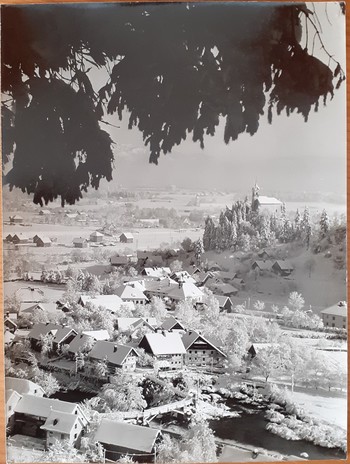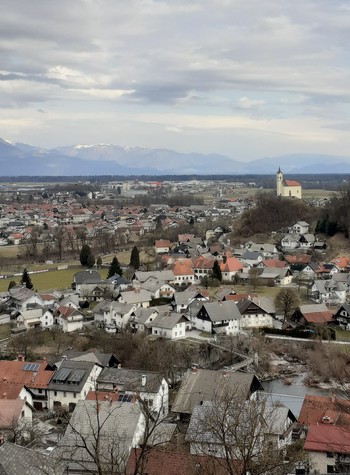Četrtek, 12. maj 2022
Škofja Loka Through Mlakar's Eyes
by Ophélie Chapuis


I arrived in Škofja Loka from France 3 months ago, to volunteer at the Loški muzej. In February, I was introduced to Tone Mlakar’s work and to the museum’s project about him. As an architect and photographer, he was an important figure in the town and he was already part of my Slovenian experience before I even knew it. Among other things, he designed the Novi svet residential area where I live, the main bus station where I usually take the bus to discover the country, and he also renovated the Kino Sora where I had one of my first good memories with my roommates.
Tone Mlakar extensively photographed Škofja Loka and its daily life since the 1950s. I was presented with a task, where I would take the same photographs now, 70 years later, which I found very interesting. The first step was to choose photos from Mlakar archives. I mostly chose the town’s landmarks, locations I could recognize, or buildings I already knew they had changed. Regarding the landscapes, I didn’t know from which exact location the photographer took the picture, but I considered it as a challenge for me to find it. It felt like a game, an investigation on the track of Tone Mlakar. I spent a lot of time wandering in the town and the hills, seeking the precise point of view. I had to climb a bit and sometimes go higher and higher, not knowing when I would finally find the perfect shot. I had to rely on the landmarks and the way they were oriented in the photos. Most of the time, those key elements were the castle, the Saint Jacob church and the Holy Cross church on Hribec.
Comparing Mlakar’s photographs with what I had before my eyes made me witness the evolution of Škofja Loka, in many ways. I realized how far the town has grown, how it has been modernized and renovated. I was sometimes surprised with what I found out, such as the current whiteness of the Ursuline church, which I pass every day, and which used to have frescoes on its facade. On the contrary, the hair salon near the Capuchin bridge is still the same. I had to look at a lot of photos to make my choices and it was a real journey through time. I am glad I had this task to accomplish, as I now have a deeper knowledge of the town in which I decided to stay for almost a year. I discovered it in a dimension I could hardly have known without this project, through Tone Mlakar’s eyes, which allowed me to explore Škofja Loka’s past and evolution.
Je suis arrivée à Škofja Loka il y a 3 mois pour une mission de volontariat au Loški muzej. En février, on m’a présenté le travail de Tone Mlakar et ce que le musée prépare à son sujet. En tant qu’architecte et photographe, il a été une personnalité importante pour la ville et il faisait déjà partie de mon expérience ici avant même que je ne m’en rende compte. Il a entre autres conçu le quartier de Novi svet où je vis, la station de bus principale d’où j’ai l’habitude de partir pour sillonner le pays, et il a aussi rénové le cinéma Kino Sora où j’ai eu l’un de mes premiers bons souvenirs avec mes colocataires.
Tone Mlakar a abondamment photographié Škofja Loka et sa vie quotidienne depuis les années 1950. J’ai eu pour mission de prendre les mêmes photos aujourd’hui, 70 ans plus tard, ce qui m’a beaucoup intéressée. La première étape a été de choisir parmi les archives de Mlakar. J’ai surtout choisi les photographies des monuments de la ville, des lieux que je reconnaissais, ou des bâtiments dont je connaissais l’évolution. Quand il s’agissait de paysages, je ne pouvais pas savoir où le photographe s’était exactement placé et je l’ai considéré comme un défi. C’était comme un jeu, comme si je menais une enquête sur les traces de Tone Mlakar. Je me suis longtemps promenée dans la ville et ses hauteurs à la recherche du bon point de vue. J’ai parfois dû monter encore et encore sans savoir quand je trouverai enfin le parfait cadrage. Les monuments et leur orientation sur les photos m’ont servi de repères. Il s’agissait en général du château, du clocher de l’église Saint-Jacob et de l’église Sainte-Croix.
En comparant les photos de Tone Mlakar avec ce que j’avais devant moi, j’ai pu me rendre compte de l’évolution de Škofja Loka sous divers aspects. J’ai vu à quel point la ville s’est étendue, comment elle s’est modernisée et comment elle a été rénovée. J’ai parfois eu des surprises, comme lorsque j’ai découvert les anciennes fresques qui arboraient la façade de l’église des Ursulines devant laquelle je passe tous les jours, qui est aujourd’hui toute blanche. Le salon de coiffure près du pont des Capucins n’a, au contraire, pas changé. J’ai regardé une grande quantité de photos pour faire mon choix et c’était un véritable voyage dans le temps. Je suis contente d’avoir eu cette tâche à accomplir parce que j’ai à présent une connaissance plus profonde de la ville dans laquelle j’ai décidé de m’installer pour presque une année. Elle s’est révélée à moi dans une dimension qui m’aurait peut-être été insaisissable sans ce projet, à travers les yeux de Tone Mlakar qui m’ont permis d’explorer le passé et l’évolution de Škofja Loka.
Ophélie Chapuis
